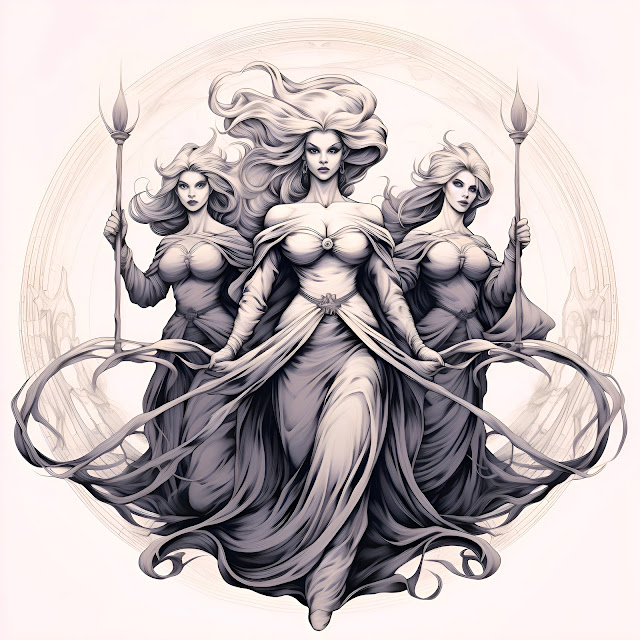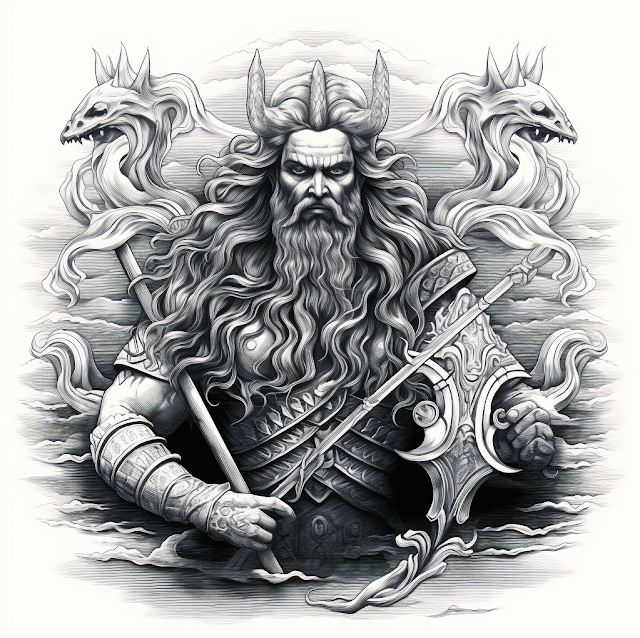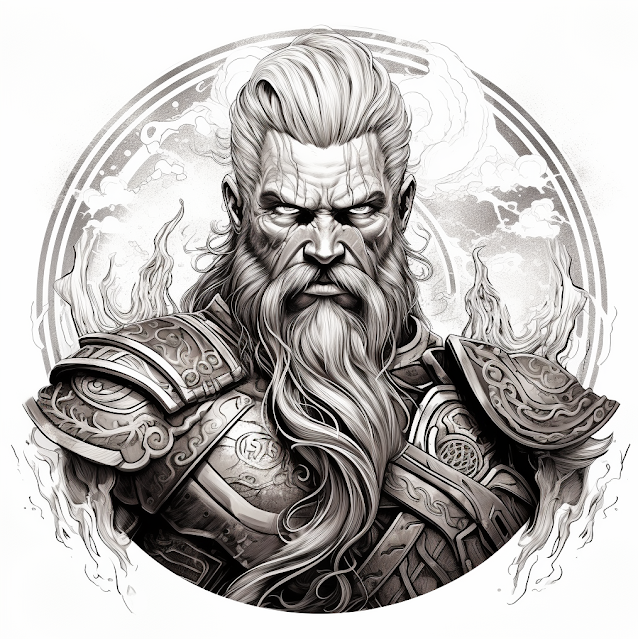Today's god leans a bit more into the Greek/Roman side of the equation, though there are still bits from the Norse and even Norse-Celtic influences. Introducing Verwildert, the God of Wild Nature and the Protector of animals, grains, and other parts of nature.
Verwildert
This god combines aspects of Pan/Fanus as well as Bacchus/Dionysus. From the Norse side, we get wilder aspects of Odin and Freyr, especially in Freyr's roles in fertility and fecundity. Many of Æsir gods of the Norse pantheon have more in common with Pan than the other Greek/Roman gods.
My group of Pagans here are living very close to nature (and Nature). Not, out some sort of neo-pagan ideal dreamed up by 20th Century writers (and 21st Century game writers), but because that was their reality. This group was a bad winter away from total barbarism and they knew that. A God like Verdwildert was the manifestation of that. The god that gave them grains and crops they could cultivate, the wolf that ate their sheep, and the storms that destroyed their farms and homes.
Nature is always just a few steps removed from madness.
VERWILDERT (God of Wild Nature)
Intermediate God
ARMOR CLASS: 2
MOVE: 36"
HIT POINTS: 280
NO. OF ATTACKS: 2
DAMAGE/ATTACK: 1d8+3, 1d8+3
SPECIAL ATTACKS: Inspire Madness, Druid magic
SPECIAL DEFENSES: +2 or better to hit
MAGIC RESISTANCE: 50%
SIZE: M (5' 9")
ALIGNMENT: Chaotic Neutral
WORSHIPER'S ALIGN: All, Farmers, Druids
SYMBOL: Hawk
PLANE: Erde
CLERIC/DRUID: 23rd level Druid
FIGHTER: 10th level Ranger
MAGIC-USER/ILLUSIONIST: Nil
THIEF/ASSASSIN: Nil
MONK/BARD: 20th level Bard
WITCH/WARLOCK: Nil
PSIONIC ABILITY: II
S: 18 I: 15 W: 22 D: 18 C: 20 CH: 23
Verwildert is the God of and the Protector of Wild Nature. He first taught humans how to cultivate land, not to tame nature, but to learn how to work with it. He is not an agricultural god, per se, but he is the patron of all growing things. He is also the god of the storm and flood that destroys, the wolf that kills, and secrets hidden it dark places.
This god appears as a grizzled old wild man of the woods, with the antlers of a stag as headdress. He is hairy and bearded. Often, his idols feature an enormous phallus, which some claim is true for the god himself. Verwildert has little time for humans, though he is not overtly hostile to them at first. Like all nature, he is dangerous and can destroy. Even he fears the raw power of Nature herself in the form of Mutter Natur, who is his own mother. Despite this human worshippers usually find Verwildert to be more approachable than Mutter Natur.
Verwildert can attack with two great fists or cast spells as a 23rd-level Druid. Three times per day, he can Inspire Madness, which will cause those who fail to save to drop their weapons (or whatever they are holding) and attack anyone close to them. Spellcasters are unable to cast spells.
Animal: All, but the Wolf is a favorite
Rainment: (Head) horns of a stag (Body) none
Color(s): Red, Green
Holy Days: Nights of the New and Full moon; Also May 1st
Sacrifices: Everything is sacred to Nature, the weakest animals culled so the pack may survive
Place of Worship: Any natural setting.
Verwildert has two groups of followers/worshipers he is associated with. The Wild Hunt and Wood Maidens.
The Wild Hunt
This band of hunters is known across the continent. In the times when Verwildert leads them, they ride and run across the land on the nights of the New Moon. These hunters are a mixed lot. Supernatural hunting dogs (like Hell hounds), undead hunters (wights), ghosts of hunters who died while hunting, and warriors not allowed into Himmel.
Wood Maidens
Wood Maidens are a type of demi-goddesses, or semi-goddesses, that are the personification of wild nature. They appear as nymphs, but are more akin to the Maenads of Greek/Roman myth. These goddess represent nature run wild. They are the goddesses of wine, ecstasy, and fertility. It is said that they are active to still the blood of men and women.
They are the face of Nature that humans try to tame but ultimately cannot.
WOOD MAIDENS (Demi-Goddess of Wild Nature, Ecstasy, and Fertility)
Demigoddess
ARMOR CLASS: 2
MOVE: 36"
HIT POINTS: 50
NO. OF ATTACKS: 2
DAMAGE/ATTACK: 1d6+1/1d6+1 (claws)
SPECIAL ATTACKS: Inspire ecstasy
SPECIAL DEFENSES: Wild Aura aura
MAGIC RESISTANCE: 25%
SIZE: M (5'2")
ALIGNMENT: Chaotic Neutral
WORSHIPER'S ALIGN: All
SYMBOL: Maiden's face
PLANE: Erde (Prime Material)
CLERIC/DRUID: 4th level Druid
FIGHTER: Nil
MAGIC-USER/ILLUSIONIST: Nil
THIEF/ASSASSIN: Nil
MONK/BARD: Nil
WITCH/WARLOCK: 5th level Witch
PSIONIC ABILITY: II
S: 13 I: 14 W: 16 D: 15 C: 18 CH: 24
Wood Maidens are demi-goddesses representing wild nature and the power to renew life. They are also the demigoddess of wine, ecstasy, and fertility. They claim they are the offspring of Verwildert and Liebhaberin or even Verwildert and Ôstara. Possibly both are true.
They can be found roaming the lands, inspiring ecstasy to renew life where they can. But they also represent nature running wild; they create life and they also can destroy it. The same ecstasy that bring lovers together can also drive them apart, or drive people to jealousy. This aura extends 60' from their person. This is increased by an additional 30' for each Wood Maiden in a group. There can be as many as dozen in a single group. This will produce an aura up to 400'.
They appear as wild women. Often running through the wilderness wearing simple clothing and often barefoot even in the deepest of winters. When they run they often have wolves accompanying them leading to the belief they are werewolves (they are not).
Wood Maidens are the chaotic counterpart to the Ides.
May 1st, May Day
On the First of May, the Wood Maiden gather in large numbers of a score or more. They can be seen running across the land, where their wild aura can extend even further. At this time they are chased by the Wild Hunt. Overtly it is so the Wild hunt can run them down in an etiological myth of Man vs. Nature. Often the Wood Maidens are captured by members of the Hunt. Just as often the Maidens kill the Huntsmen. In the case where a Maiden is captured and she doesn't kill the Huntsman, the Maiden becomes a normal human; often as a high priestess of Verwildert. The moral here is that Humankind can't tame nature, much less conquer it.
This is symbolically celebrated in a fertility rite where the young women of the community run through the woods in an attempt to be captured by the young men. The women wear flowers in their hair which they can give to whomever finds them. This is considered akin to a marriage proposal. It is said that any child conceived in these rites is blessed by the gods.
For Use in NIGHT SHIFT
Of all the myths I have written, this is the one most likely to have survived to modern times to feature in NIGHT SHIFT. It is a Folk Horror sort of tale. Think "Midsommer" and "The Wickerman."
A good hook is something from Norse/Germanic myths. The PCs are on some sort of hiking trip, and they come across a nearly naked young woman running through the woods chased by something. The PCs naturally try to help her, only to discover that she is part of an ancient rite. Is she innocent? Is she the monster? Likely it will be more complicated than that.
I'll need to develop these more.
Links
- One Man's God Special: Syncretism Part 3, the Roman-Norse Pantheon
- The Monsters
- The Gods
- Unser Vater, Father of the Gods
- Sisters of the Dawn, Liebhaberin and Ôstara
- The Mother Goddesses Herde Oberin, Mutter Natur, and Großmutter
- The Divine Twins
- Hüne Vater, Großvater, and Großmutter
- Ides, Demi-Goddess of Protection and War
- Helga, Goddess of Magic, Ghosts, and Witchcraft
- Hüter, Lord of the Dead
- Betrüger, The Trickster God
- Kriegskönig, The God of War
- Verwildert, the God of Wild Nature
- Wood Maidens



.jpg)













